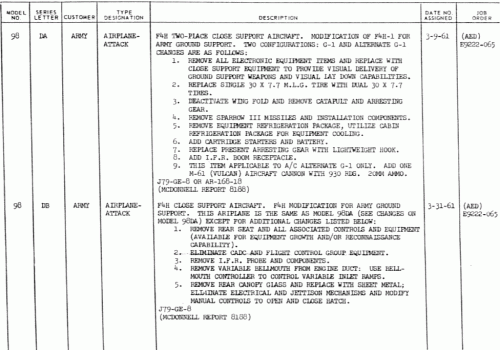ksimmelink
Phormer Phantom Phixer
I have been compiling information on the Phantom II for years, being an old Crew Chief on F-4C, F-4D and a very brief stint with the F-4E I have a real love for the aircraft. But I was very shocked to find out that in 1961 McDonnell had proposed "dumbed-down" Phantom II's to the Army for Close Air Support. This was odd on several levels.
First, after the split of the Army Air Corps to become the Air Force, the Army was restricted in using aircraft (they were to depend on the Air Force to do the flying) and especially precluded from arming aircraft in any way. Prior to Viet Nam they had to very quietly arm the OV-1 (by having the Marines be a joint partner even though the navy would probably never buy the OV-1 for them) and their helicopters to test them and develop weapon systems which would work in war time. By the time bullets started flying in Viet Nam the Army could arm their aircraft and helicopters as something that already was accomplished and who would tell them that they couldn't defend themselves, and to take the weapons back off. But they were able to get aircraft like the OV-1 by saying it was a reconnaissance and observation aircraft.
So where did McDonnell think that offering a Phantom II (model 98DA two seat and model 98DB single seat) no matter how stripped down they were was even possible.
It would have been a neat thing to see though, making the Phantom II (which already was the first three-service aircraft) the first and probably only four-service aircraft.
First, after the split of the Army Air Corps to become the Air Force, the Army was restricted in using aircraft (they were to depend on the Air Force to do the flying) and especially precluded from arming aircraft in any way. Prior to Viet Nam they had to very quietly arm the OV-1 (by having the Marines be a joint partner even though the navy would probably never buy the OV-1 for them) and their helicopters to test them and develop weapon systems which would work in war time. By the time bullets started flying in Viet Nam the Army could arm their aircraft and helicopters as something that already was accomplished and who would tell them that they couldn't defend themselves, and to take the weapons back off. But they were able to get aircraft like the OV-1 by saying it was a reconnaissance and observation aircraft.
So where did McDonnell think that offering a Phantom II (model 98DA two seat and model 98DB single seat) no matter how stripped down they were was even possible.
It would have been a neat thing to see though, making the Phantom II (which already was the first three-service aircraft) the first and probably only four-service aircraft.


